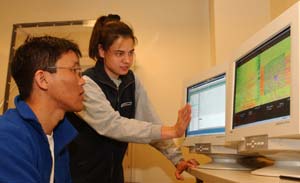Purdue researchers stretch DNA on chip, lay track for future computers

Physics doctoral student Dorjderem Nyamjav, left, and Albena Ivanisevic, an assistant professor of biomedical engineering at Purdue University, review an image taken with an atomic force microscope. The researchers have developed a method for precisely placing strands of DNA on a silicon chip and then stretching out the strands so that their encoded information might be clearly read, two steps critical to possibly using DNA for future electronic devices and computers. (Purdue News Service photo/David Umberger
Researchers at Purdue University are making it easier to read life’s genetic blueprint.
They have precisely placed strands of DNA on a silicon chip and then stretched out the strands so that their encoded information might be read more clearly, two steps critical to possibly using DNA for future electronic devices and computers.
Findings about the research are detailed in a paper posted online this month and will appear in an upcoming issue of the journal Advanced Materials. The paper was written by Albena Ivanisevic, an assistant professor of biomedical engineering at Purdue, and physics graduate student Dorjderem Nyamjav.
Ivanisevic and Nyamjav created templates containing charged lines of commercially available polymer. The positively charged polymer has the opposite charge as DNA, so when the genetic material is dropped onto the chip, it is attracted to the lines automatically. Then the researchers used a syringe to drag the DNA, uncoiling the strands along the template surface.
“The charged structures enable us to direct biological molecules in a certain location,” Ivanisevic said.
Although other researchers have deposited DNA onto similar templates, Ivanisevic is the first to demonstrate how to also stretch strands of DNA in specific locations on such templates, which contain features so small they are measured in nanometers. This step could lead to the ability to stretch DNA molecules in specific locations on electronic chips, which is critical in harnessing the storage capacity of DNA for future computers.
“We don’t want to have DNA coiled on the surface,” Ivanisevic said. “We want to be able to extend it and stretch it so that you can read what’s on the strand. You can think about a variety of DNA computing strategies. But you have to have the strand extended, and you have to have the ability to place it in a specific location.”
Researchers also would like to be able to place DNA strands directly between two electrodes to perform consistent, precise measurements and determine certain electronic characteristics of genetic material.
“If you can actually demonstrate that you can do that, then you can think about making real molecular devices where DNA is used as a construction material,” Ivanisevic said. “At this point, however, this is certainly a very basic nanofabrication problem.”
Theoretically, future computers might tap the vast storage capacity that enables DNA to hold the complex blueprints of living organisms. These new computers would be based on DNA’s four-letter code instead of a computer’s customary two digits and would offer advantages in speed, memory capacity and energy efficiency over conventional electronics for solving certain types of complex problems.
The researchers used an instrument called an atomic force microscope and a device called a cantilever to lay down the lines of polymer in a process called dip-pen nanolithography. Each of the lines of polymer is about as wide as 100 nanometers, and each centimeter-square chip contains numerous templates.
“Nano” is a prefix meaning one-billionth, so a nanometer is one-billionth of a meter, or roughly the length of 10 hydrogen atoms strung together. A single DNA molecule is about 2 nanometers wide.
The same technique can be used to precisely place a variety of biological molecules, including proteins and viruses, onto such templates. It is not necessary to dry out or stain the molecules, meaning they can be kept in their natural state and still function as they would in living organisms.
Because the polymer is commercially available, the procedure can be readily studied by researchers and industry.
Ivanisevic is associated with two centers in Purdue’s Discovery Park: the Birck Nanotechnology Center and Bindley Bioscience Center, which funded the research.
Writer: Emil Venere, (765) 494-4709, venere@purdue.edu
Source: Albena Ivanisevic, (765) 496-3676, albena@purdue.edu
Purdue News Service: (765) 494-2096; purduenews@purdue.edu
Media Contact
All latest news from the category: Information Technology
Here you can find a summary of innovations in the fields of information and data processing and up-to-date developments on IT equipment and hardware.
This area covers topics such as IT services, IT architectures, IT management and telecommunications.
Newest articles

Innovative 3D printed scaffolds offer new hope for bone healing
Researchers at the Institute for Bioengineering of Catalonia have developed novel 3D printed PLA-CaP scaffolds that promote blood vessel formation, ensuring better healing and regeneration of bone tissue. Bone is…

The surprising role of gut infection in Alzheimer’s disease
ASU- and Banner Alzheimer’s Institute-led study implicates link between a common virus and the disease, which travels from the gut to the brain and may be a target for antiviral…

Molecular gardening: New enzymes discovered for protein modification pruning
How deubiquitinases USP53 and USP54 cleave long polyubiquitin chains and how the former is linked to liver disease in children. Deubiquitinases (DUBs) are enzymes used by cells to trim protein…



